Installation
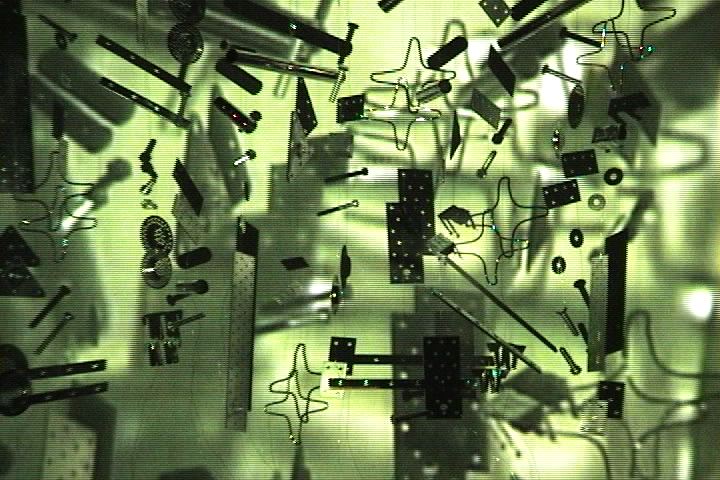
SHINES
2007 - closed circuit video feedback and self-producing sound installation for:
- many different metallic objects (selected for both sound and aspect)
- metal wire
- 8 piezo mics with a passive mixer
- 1 amplifier and 2 speakers
- 2 electric fans
- 1 color surveillance camera with zoom lens
- 1 video projector
Suspended shiny metal objects from the hardware store that strike each other - captured by a closed-circuit video camera and piezo mics - form the basis of the image and sound of this constantly fluctuating "video-audio installation-sculpture-painting" involving no recorded video or audio components.
Created at O', Associazione Non Profit per la Promozione delle Ricerche Artistiche in Milano, Italy, within in the context of their O'A.I.R. - Artisti in Residenza Program. Presented at O'artoteca, Milano in December 2007.
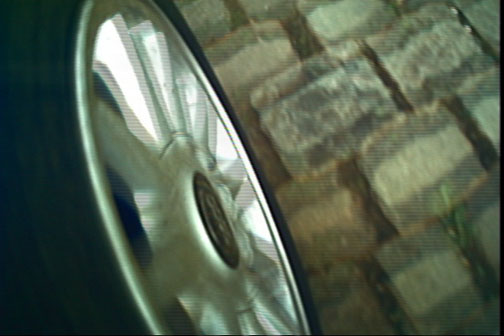
FOUR-WHEEL DRIVE
2007 - video-audio installation for:
- 4 DVD players
- 4 data projectors
- 1 CD player
- 4 high quality speakers and an amplifier for the sound collage on the CD
video: Katherine Liberovskaya
sound collage: Phill Niblock
"Four-Wheel Drive" is a sonic video installation piece consisting of 4 projections and a quadrophonic sound collage. It reframes visual and sonic properties of automotive technology into artistic content by way of surveillance technology. It explores the "musicality" and tactility of the movement of the wheels (tires) of a moving car on different types of road surfaces to create an immersive audio-visual experience.
The concept consists in attaching a small surveillance camera and a microphone to the body of a car, just above each of the wheels with the lens and capsule aimed towards the road, and recording the image and sound while the car is in motion. The exercise is repeated for each of the 4 wheels on a different kind of road surface (concrete, gravel, grass, cobble stone...). The resulting 4 sequences of extremely close-up views of moving wheels and roads will form 4 loops that will be projected (from DVDs) on 4 large-scale screens or surfaces in a space where it will ideally be possible to present 2 projections per wall on 2 facing walls so as to reference the configuration of the four wheels of a car.
From the recorded audio material, NY composer Phill Niblock will develop a thick, multi-layered sound collage. This immersive quadrophonic sonic environment, where the different sources of sound will interact with each other, will itself interact with the space and with the extreme close-up footage of the wheels and roads that become, by virtue of the large scale presentation, huge tactile textured abstract moving images evoking gigantic floating hyperreal color-field paintings drifting away from their association with reality.
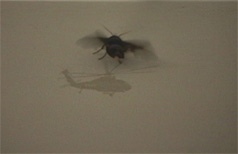
TAKE-OFF
2006 - video projection, 24 minute loop
video: Katherine Liberovskaya
music: Al Margolis (IF, BWANA)
Take-off originated with a musical work-in-progress that composer Margolis proposed to video artist Liberovskaya as a point of departure for a collaborative piece. Margolis's drone evoked for Liberovskaya a series of images which she shot and began to put together. From this point on, over some 12 months, both the music and video evolved in additions and substractions, at times in reaction to one another, at times on their own. The piece is thus the result of a back-and-forth dialogue between image and sound where flying machines flutter and flying creatures rumble in flickering bombinating juxtaposed layers.
Take-off can be, and has been, shown as a single-channel work (in a version with a title and credits) or as an installation (in an auto-looping version with no credits or titles).
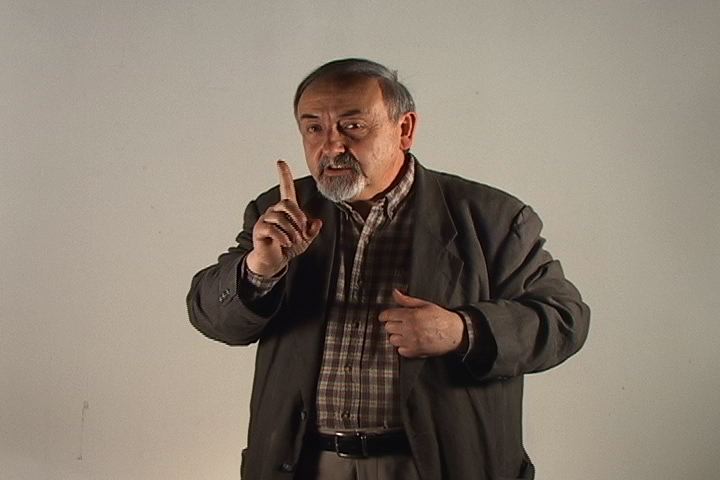
STORIES FOR THE EYES (while waiting for the tram)
2006 - video installation for 2 video monitors (2 different looping DVD videos, no sound), approx. 15 minute loop
On the one hand this project fits into a body of artistic work of the past few years based on the process of collecting large series of monologues from the most diverse people on different thematic topics. On the other hand, it was specifically inspired by the conditions of the EI v.z.w. Gent window gallery, with its impossibility to feature any sound, and by its particular physical situation. Adjacent to the Muidebrug tram stop and looking out onto the harbor of a canal leading to the North Sea in the city's historic dock area, the location has always been at the heart of comings and goings of multitudes of people with multitudes of stories to tell. All these factors contributed to the concept of 'Stories for the Eyes': a collection of monologues that tell stories without using speech. I asked over a dozen friends and acquaintances to tell stories using only facial expressions and hand and body gestures. Their only directive was that these stories be addressed to the passers-by and to the people waiting for the tram at the Muidebrug stop. My interest for these stories was not in any official sign language, but in the unique personal sign languages people who usually communicate with speech may come up with if asked to narrate a story without talking. These often obscure personal sign languages that cross cultural and racial boundaries turn the reception of the stories into a guessing-game meant to create an active relationship between the gallery and the street: stories for the eyes... while waiting for the tram...
With the participation of: Carlos Andrade, Sükran Aziz, Martine Crispo, Eric Dunlap, Shelley Hirsch, Miwa Koizumi, Koosil-ja, Al Margolis, Kenard Meyers, Charlie Morrow, Ursula Scherrer, Sami van Ingen, Elsa Viera, Fuat Yalim
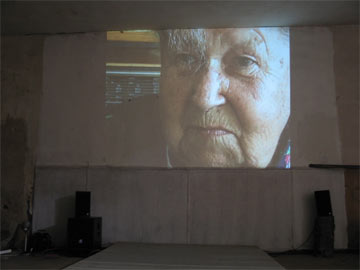
ORAL MOOSTORY
2006 - single-channel video-audio installation, approx. 50 min. loop
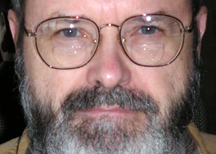
70 for 70 (+ 1): Seventy (One) Sides of Phill Niblock
2003-2004, video installation for one monitor or one projection, 103 minute loop
A dynamic portrait composed from fragments of seventy (+ 1) extremely close-up interventions on video about intermedia composer Phill Niblock by seventy (+ 1) people connected to him in some way. These interventions, or monologues, were collected in honor of his seventieth year (2003-2004) and the piece has been completed in time for his 71st birthday, October 2nd 2004.
With: Chris Anderson, Thomas Ankersmit, Jeff Bauer, David Behrman, Tara Bhattacharya, Maria Blondeel, Krystyna Borkowska, Jens Brand, Tom Buckner, Yu-Fei Chen, Steve Dalachinsky, Irina Danilova, Guy De Bièvre, Micheal Delia, John Duncan, Jean Dupuy, Angie Eng, Dan Evans Farkas, Esther Ferrer, David First, Bernhard Gal, Dave Geary, Madeleine Gekiere, Malcolm Goldstein, Annie Gosfield, Matt Griffin, Shelley Hirsch, Andrea Hull, Tom Johnson, Seth Josel, Tomi Keranen, Roger Kleier, Hans W. Koch, Yumi Kori, Mary Jane Leach, Okkyung Lee, Katherine Liberovskaya, Alan Licht, Chris Mann, Frankie Mann, Al Margolis, Eric Mattson, Charlie Morrow, Boris Nieslony, Morgan O'Hara, Yuko Otomo, Paul Panhuysen, Vitaly Patsyukov, Emanuel Dimas de Melo Pimenta, Matt Rogalsky, Jurgita Remeikyté, Don Ritter, Ursula Scherrer, Claudia Schmacke, Micheal Schumacher, Shelly Silver, Jim Staley, Gerd Stern, Volker Straebel, Elaine Summers, Micheal Timpson, Yasunao Tone, Jo Truman, Keiko Uenishi, Ruben Verdadeiro, David Watson, Monika Weiss, Anne Wellmer, Amnon Wolman, Dion Workman, Nina Zaretskaya.
It is worth noting that the choice of participants was a much more incidental than pre-determined process, except for the goal of reaching a total of seventy. Each was invited to briefly say anything they wanted to, or to express themselves in any way they like, about Niblock -- within the constraints of a very tight shot of their face. The result is an intimate collage of meditations, reminiscences, anecdotes, stories, impressions, feelings... from seventy one different angles: seventy (one) sides of Phill Niblock.
TOPOLO: DE PASSATO A AVVENIRE
2004-2005 - multi-channel video-audio installation
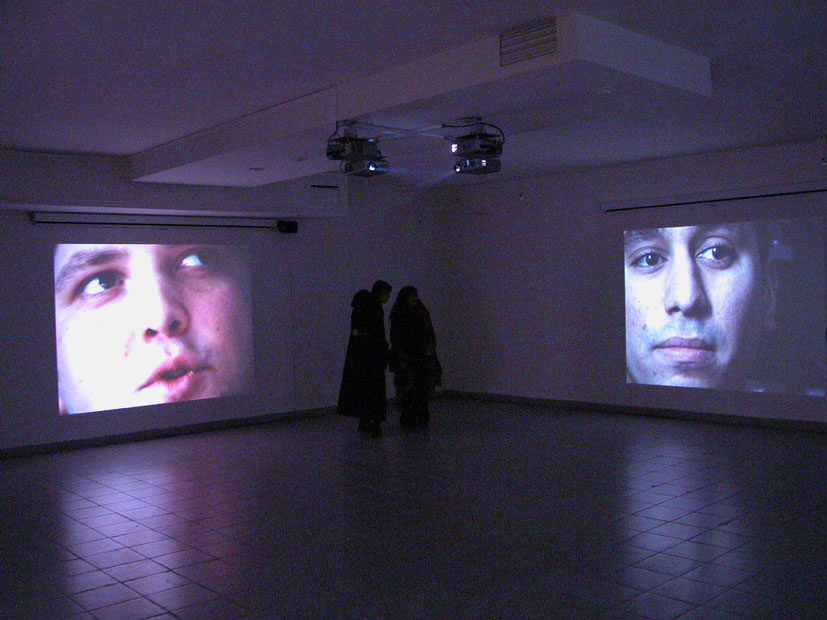
BABEL-ON
2002-2003 - 5 channel video-audio installation/performance
- sync-sound video: Katherine Liberovskaya
- sound piece: Phill Niblock
Inspired by the biblical tale of the Tower of Babel and the Confusion of Tongues, BABEL-ON is a sound-based audio-video work-in-progress exploring the melodic and rhythmical dimensions of human spoken languages as musical instruments of communication and concentrates on the sound of verbal expression rather than on its meaning.
The four simultaneous projections display different successions of video clips of a wide variety of very tight shots of the faces of women and men of different nationalities and/or origins speaking in their mother-tongues about the musical-rhythmical properties and idiosyncrasies of their respective languages as well as strive to remember tongue twisters or rhymes. In counterpoint to these video projections with their sync sound, concurrently plays a sound composition, derived from voices and languages, by Phill Niblock. Constructed from the actual utterances in the video footage, this thick, numerous track, composition forms an acoustic environment that interacts with the multilingual speech, at times accompanying it, at others overriding and replacing it, at still other times growing silent, thus creating a sonic conversation of sorts. BABEL-ON is meant to create a very physical, living audio-video flow of variations of associations and dissociations, of different tensions, between image and sound, speech and music, words and significations, intention and chance, a constant flux of unstable, slipping, shifting meanings and perceptions. It is an experiential piece that evokes the non-verbal possibilities of vocal communication, suggesting various relationships between diverse geo-political regions, cultural traditions and civilizations.
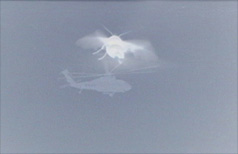
THE MURMURING OF THE TONGUES (LE BRUISSEMENT DES LANGUES)
1992 - 60mn. 6 channel video installation for 14 monitors and 1 video projector.
This piece, created for the exhibition "A MILLE LIEUX" presented at the Marché Bonsecours in the context of the 500th anniversary of the city of Montreal, is a reflection on the multi-ethnic nature of the city. 12 monitors on boat shaped podiums presented the talking heads of 24 elderly peopole of 24 different local ethnic communities that told the stories of how and why they or their ancestors immigrated to Montreal. These stories were told in their mother tongues without subtitles thus creating an "orchestra" of simultaneous languages. The "boats" converged to a 12' high triangular shaped mirror. In the centre of this mirror was a 6' X 8' opening behind which, slightly set back, stood a projection screen of the same dimension. The projection on the screen was a contemplative and synthetic mandala-like representation of Montreal where commercial signs in a multitude of languages from all over the city - the visible symbols of cultural communities - pulsated like a heart beat in the waters of the rivers that surround the island city. As the visitor walked through this opening s/he found 2 more monitors - at each side of the projection screen - that showed the talking head of an elderley Mohawk Indian woman telling the native legend of the genesis of the North American continent. The sound track, created by Montreal composer Michel Smith, was essentially constructed from water sounds giving one the impression of being surrounded by waves.

TO SEE INFINITY IN THE PALM OF YOUR HAND (DE MAIN EN MAIN L'INFINI)
1992 - interactive multi-media installation for:
- 4 walls
- 128 sheets of printed computer paper
- 1 Macintosh Classic
- 2 boxes of computer paper
- 1 video closed circuit with 1 camcorder
and 8 monitors
- 1 music stand
- 1 small white porcelain vase
- 8 white lead pencils
- 1 large magnifying glass on a stand
- 3 pennies
This installation, presented at la Centrale/Galerie Powerhouse in September 1992, was a sort of game proposed to the visitor. Upon entrance s/he received an envelope containing 3 cents and instructions for throwing the I Ching oracle. Around the walls of the space hung a series of 64 inter-related questions in alternation with the 64 hexagrams of the I Ching printed out on computer paper. These formed a narrative loop. In the center of the gallery was a Macintosh computer with a hard-drive containing the entire I Ching divided into 64 one page files for the 64 hexagrams. The visitor could "consult" the computer for the meaning of any one of the hexagrams he had seen on the walls or throw a hexagram of his own with the 3 cents he had received. The Macintosh was hooked to a printer, allowing the visitor to print-out the page of his choice for the cost of 3 cents. A closed circuit video system transmitted the content of the computer screen to 8 monitors placed in a circle around it, thus making public the private consultations of the visitors.